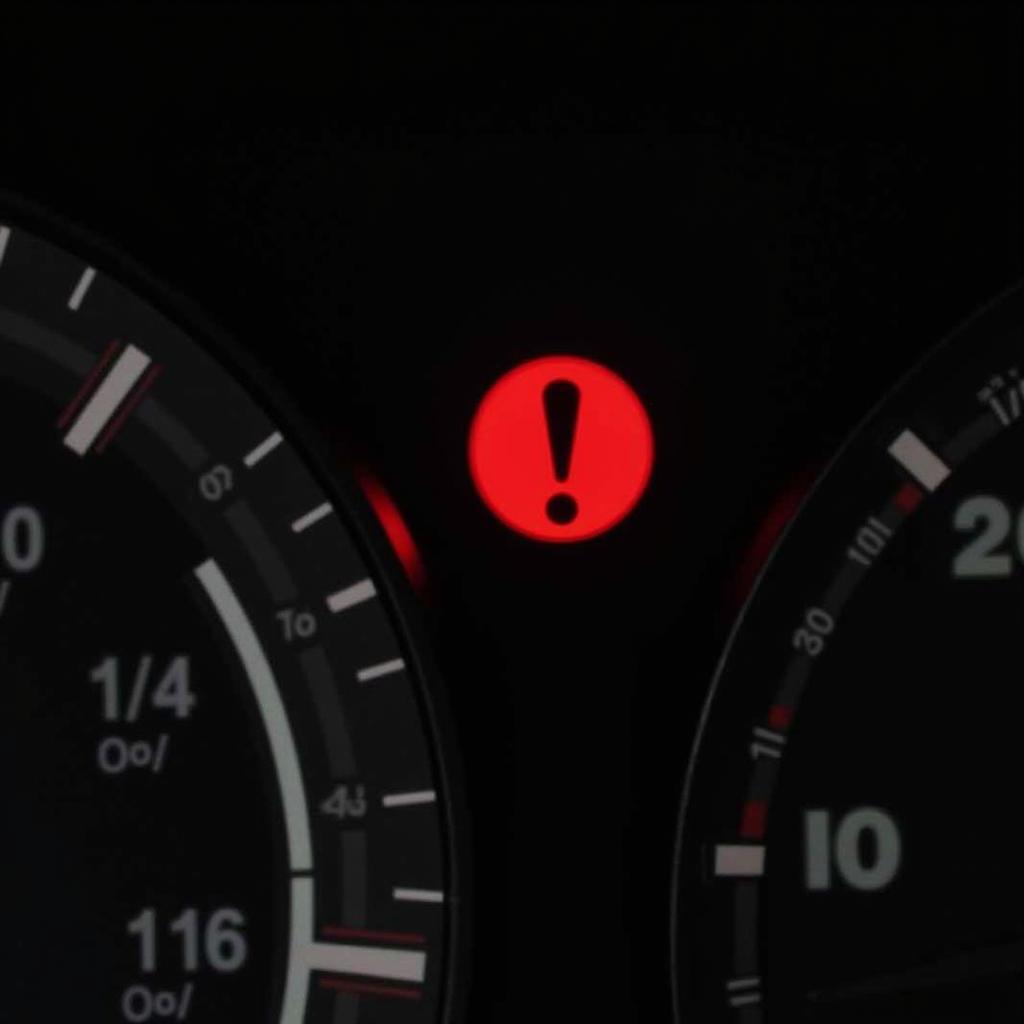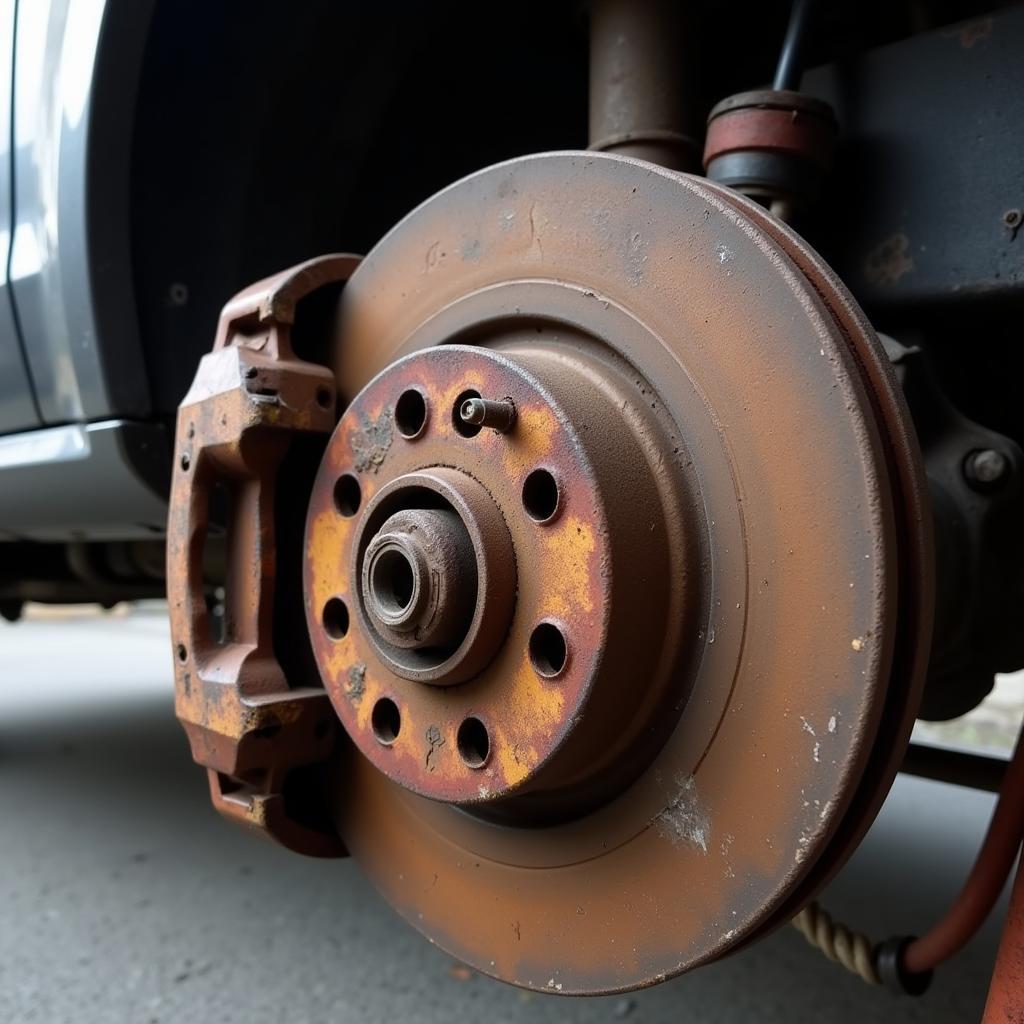The parking brake warning light is a safety feature found on the dashboard of your vehicle. It’s designed to alert you about a simple yet crucial aspect of your car: the parking brake. This light, often depicted as a red circle with an exclamation mark or the letter “P” inside, usually illuminates when the parking brake is engaged. While this might seem straightforward, there are instances where the parking brake warning light can indicate underlying issues with your car’s braking system.
This article delves into the different reasons why the parking brake warning light might turn on, how to diagnose the problem, and what steps you can take to resolve it.
Understanding the Parking Brake Warning Light
In its simplest form, the parking brake warning light functions as a reminder. When you engage your parking brake, the light on your dashboard turns on. Releasing the parking brake should subsequently turn off the light. However, if the light remains on or flickers intermittently, it usually signals a potential problem.
Common Reasons Your Parking Brake Warning Light is On
There are several reasons why your parking brake warning light might be illuminated even when the parking brake is disengaged:
- Low Brake Fluid: One of the most common reasons for this warning light is low brake fluid. The parking brake system often shares fluid with the hydraulic brake system. If the fluid level drops too low, it can trigger the warning light.
- Solution: Check your brake fluid level and add more if necessary. If you’re frequently adding fluid, you may have a leak that needs to be addressed by a mechanic.
- Faulty Parking Brake Switch: The parking brake switch is responsible for detecting whether the brake is engaged or released. A faulty or malfunctioning switch might send incorrect signals to the car’s computer, causing the light to stay on.
- Solution: A mechanic can test the switch and replace it if necessary.
- Worn Brake Pads or Shoes: While less common, worn brake pads or shoes can sometimes trigger the parking brake warning light, particularly in vehicles where the systems are closely linked.
- Solution: Have a mechanic inspect your brake pads and shoes for wear and tear.
- Electrical Issue: Like any other electrical system in your car, the wiring and connections related to the parking brake can become damaged or corroded. This can lead to a false signal and illuminate the warning light.
- Solution: A mechanic can inspect the wiring harness for any issues and repair or replace damaged components.
- Problem with the ABS System: In some vehicles, the parking brake warning light can also be linked to the Anti-lock Braking System (ABS).
- Solution: If you suspect an issue with your ABS, it’s best to consult with a qualified mechanic for diagnosis and repair.
Diagnosing the Problem
 Parking brake warning light on a car's dashboard
Parking brake warning light on a car's dashboard
Here’s a step-by-step guide to help you diagnose why your parking brake warning light is on:
- Check Your Parking Brake: The first step is to ensure the parking brake is fully released. Sometimes, the brake may not be entirely disengaged, causing the light to stay on.
- Inspect Brake Fluid Level: Locate the brake fluid reservoir under the hood. Check the fluid level, ensuring it’s between the minimum and maximum markers.
- Visual Inspection: Take a look at the visible components of your parking brake system. Check for any loose or damaged cables, as well as signs of wear or corrosion.
- Consult a Mechanic: If you’ve ruled out the simple fixes and the warning light persists, it’s time to consult with a qualified mechanic. They have the tools and expertise to diagnose and repair more complex issues with your braking system.
Importance of Addressing the Parking Brake Warning Light
Ignoring a persistent parking brake warning light can have serious consequences. Here’s why you shouldn’t ignore this warning:
- Safety Hazard: A malfunctioning parking brake can put you and others at risk. Your car could potentially roll away if the parking brake isn’t working properly.
- Further Damage: Ignoring the warning light could lead to more severe damage to your vehicle’s braking system, resulting in costly repairs.
- Legal Issues: In many jurisdictions, driving with a faulty parking brake is illegal and could result in fines or penalties.
Preventing Parking Brake Problems
Here are some proactive steps you can take to prevent parking brake problems:
- Regular Maintenance: Follow your vehicle manufacturer’s recommended maintenance schedule. This usually includes inspecting and servicing the braking system at regular intervals.
- Engage Parking Brake Properly: Ensure you fully engage the parking brake when parking, especially on an incline.
- Address Warning Signs: Never ignore any warning lights on your dashboard, especially those related to your braking system.
Remote Diagnostics and Software Solutions
In today’s technologically advanced world, remote diagnostics and software solutions are becoming increasingly common in the automotive industry.
“Remote diagnostics allow us to access a vehicle’s computer system from anywhere in the world,” says John Miller, a certified automotive technician with over 20 years of experience. “This means we can often identify and diagnose problems with the parking brake system, and even perform software updates or resets, without the vehicle ever needing to come into the shop.”
This can be particularly helpful for addressing issues related to the electronic components of the parking brake system, such as faulty sensors or software glitches.
Conclusion
The parking brake warning light, though often overlooked, plays a vital role in ensuring the safety and functionality of your vehicle. Understanding what triggers this light and knowing how to address the underlying issue can save you from potentially dangerous and costly situations.
Remember, when it comes to your car’s braking system, prevention is always better than cure. Regularly maintaining your vehicle and addressing warning signs promptly can go a long way in keeping you safe on the road.
FAQs
- Can I drive with the parking brake warning light on?
It’s highly discouraged to drive with any warning light illuminated, especially those related to your brakes. While driving short distances might be possible, it’s crucial to have the problem diagnosed and fixed as soon as possible. - How much does it cost to fix a parking brake?
The cost of repair depends on the underlying cause. Simple fixes like adding brake fluid or adjusting the parking brake cable are relatively inexpensive. However, more complex repairs like replacing the parking brake assembly or fixing electrical issues can be significantly more expensive. - How often should I check my brake fluid?
It’s a good practice to check your brake fluid level at least once a month. You should also check it if you notice any changes in your brake pedal feel or if the parking brake warning light comes on. - Can I fix my parking brake myself?
While some parking brake issues are simple fixes, it’s generally recommended to have a qualified mechanic diagnose and repair any braking system issues. This ensures the job is done correctly and your car is safe to drive. - What is an electric parking brake?
An electric parking brake, also known as an electronic parking brake, is a newer technology that replaces the traditional hand-operated lever or foot pedal with a button. When engaged, the electric parking brake uses an electric motor to apply the brakes. You can learn more about common issues with the electric parking brake on a 2016 Honda HRV parking brake warning lights. - Why is my parking brake warning light staying on in my 2002 Mercury Sable?
There could be several reasons specific to your 2002 Mercury Sable. It could be a faulty parking brake switch, a low brake fluid level, or an issue with the wiring. It’s best to have a mechanic diagnose the problem. - What if my Cadillac XT5 parking brake warning light is flashing?
A flashing parking brake warning light in your Cadillac XT5 could indicate a problem with the electronic parking brake system. This might require a diagnostic scan to identify the specific fault code and determine the necessary repair.

